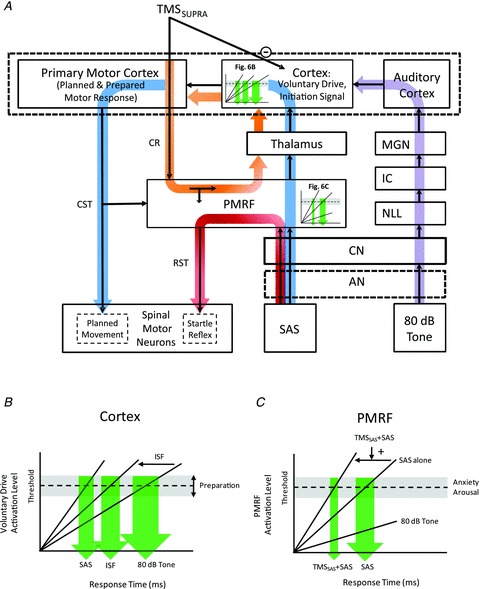Figure 6. Model of the pathways mediating the release of movement in response to an 80 dB tone (Control trials), a SAS, TMSSAS alone and TMSSAS+SAS.

This model shows two primary pathways (blue and purple) by which planned and prepared movements can be released by a sensory stimulus. The right portion of the model (purple line) shows the classic pathway by which a low intensity acoustic tone (e.g. 80 dB) travels to the auditory cortex. The auditory cortex then has input to a voluntary drive or initiating signal that triggers the release of the planned and prepared movement sequence at the level of the cortex. The timing and distribution of the response time is dependent upon the rate of rise of the input and the threshold to triggering the response, both of which can be modulated by intersensory facilitation or the level of preparation (Fig. 6B). Disruption of voluntary drive by suprathreshold TMS delays the release of the movement (TMSCT condition). The presentation of a SAS results in a synchronous afferent volley travelling to the PMRF and releasing a generalized startle reflex (SCM burst) via known pathways (shown in red). However, the timing of the generalized startle response can be altered by descending cortico-reticular input produced by TMS (orange line and Fig. 6C). The TMS-evoked volley to the PMRF increases the rise time of the startle triggering signal and produces both a reduction in startle onset latency and narrowing of the distribution of response times. Note that a decrease in threshold would not explain our results since this would not produce a narrowing of the response time distribution. Similar to the SAS response mechanism (shown in blue loop), the TMSSAS alone can trigger the early release of the planned movement through cortico-reticular inputs to the PMRF and a subsequent ascending volley via reticulo-thalamocortical pathways to the voluntary drive/initiation signal region of the cortex (shown in orange loop). Abbreviations: AN, auditory nerve; CN, cochlear nucleus; CR, corticoreticular projection; CST, corticospinal tract; IC, inferior colliculus; ISF, intersensory facilitation; MGN, medial geniculate nucleus; NLL, nuclei of the lateral lemniscus; PMRF, pontomedullary reticular formation; SAS, startling acoustic stimulus; SCM, sternocleidomastoid muscle; SUPRA, suprathreshold; RST, reticulospinal tract; TMS, transcranial magnetic stimulation.
